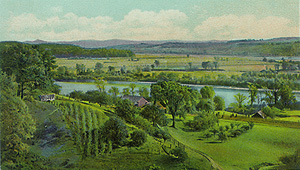|  The Nile of New England:
The Nile of New England:
A Study of the History of a Connecticut River Valley Town Over Three Centuries
An Inquiry-based Social Studies Unit for High School Students
Course Central Question:
What were the distinguishing characteristics of the people of the Deerfield and their relationship with the land as illustrated through changes in lifestyles, economy, and governance?
Primary Authors
Dr. Janice Dore, Library/Media Center Director
Susan McGowan, Humanist-in-Residence, Pocumtuck Valley Memorial Assoc.
Full Curriculum Credits
This curriculum is a semester-long course and is comprised of three units:
Unit 1: The Colonial Period 1680-1720
13 lessons in 14 class periods (85 minutes each)
Deerfield was a frontier community, settled by English people who desired land and an opportunity for prosperity. We will learn about the people who came to settle Deerfield, why they were determined to create a town "in the wilderness," how their religion served as comfort and inspiration, and how they functioned as an interdependent community in the formative years of the town. Conversely, we will attempt to understand reasons for constant warfare and the nature of the porous border that enclosed them.
Unit 2: The Federal Period 1780-1820
15 Lessons, 23 Class Periods (85 minutes each)
A consequence of wider interchanges and expanding economic success was the desire for refinement as manifested by the River Gods. This was a time of beautification along the main street - trees were planted and a number of houses were built or remodeled in the new fashion. Educational opportunities expanded. We will chart this increased prosperity and identify elements of refinement with the study of inventories, tax lists, and by the comparison of early dwellings with those erected at the time of and after the American Revolution.
Unit 3: The Progressive Era 1880-1920
8 lessons in 13 class periods (85 minutes each)
Deerfield changed markedly influenced by national events: the economy, immigration, migration to the west, the Civil War, inventions, and industrialization. We will study each of these areas to learn of their impact and Deerfield's response to them. Students will be asked to develop materials throughout the unit that will culminate in the development of artifacts: a scrapbook, a newspaper, or a photograph album.
You can preview the teacher background material from Teacher Background Essays.
Features of the Course
• The course features an inquiry-based curriculum, based on constructivist learning theory.
• Students will learn to become historians, understanding the historical process by teasing out meaning through the use of historical evidence and conjecture.
• Students practice critical thinking skills.
• Students are actively involved at the center of their learning.
• Students are transcribing and analyzing primary documents.
• Technology integration is an integral part of the curriculum. Students are asked to use technology both as a tool for research and as a tool for creative presentations.
• Students are often assessed by using rubrics. The rubrics provide opportunities for students to self-evaluate their own work prior to submitting it for formal evaluation.
• Students are asked to participate in group work involving cooperative learning strategies.
• Students are continually being asked to write.
• Students have frequent practice using research skills.
• Students are expected to credit their sources of information.
• Students understand the importance of substantiating their statements with sources to corroborate their information/positions.
• Students are using organizational skills when presenting information.
• Students have an opportunity to creatively present their finished work.
• Students are graded using authentic assessments throughout the class.
top of page
|





